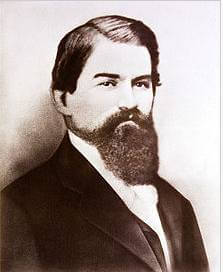
A “Money Counts” merit badge? I guess greed really is good.
The first National Girl Scout Cookie Day was celebrated on February 8, 2013, created to “highlight the real purpose of the $790-million cookie program, which is to teach girls five essential skills: goal setting, decision making, money management, business ethics, and people skills.”
It appears not everyone buys into GSblog’s statement that cookie fans should order boxes “in honor of their success in running the largest girl-led business enterprise in the world.”
While researching this seemingly sweet and innocent holiday, I discovered a groundswell of belief that these cookie pushers have darker purposes. I found it in, of all places, The Washington Post, in the comment section of an article about how supply chain problems are affecting the production of Girl Scout cookies.
For context, a top article that day stated Biden’s White House would distribute 400 million free N95 masks to help control the spread of COVID-19, which continues to ravage Earth’s populace abetted by a concurrent plague of ignorance.
Another story detailed how AT&T and Verizon agreed to limit their rollout of new high-speed 5G networks near airports due to their potential to interfere with “airplane safety technology.” Turns out conspiracy theorists who shriek that 5G transmits COVID-19 simply lack imagination. For my money, dying in a plane crash because some idiot is checking his phone for up-to-the-minute health advice from Joe Rogan is way scarier. (Because of course those same folks will use 5G with no sense of irony. It’s faster.)
I normally stay away from comment boards for reasons anyone who doesn’t enjoy a headlong plunge down a manhole will understand. But a story about cookies, one that mentions Adventurefuls, the new “brownie-inspired cookies with caramel flavored crème and a hint of sea salt” seemed like a low-stakes issue. (I was a Girl Scout once. I never earned a merit badge and quit owing 20¢ in dues. I shudder to think how much interest has accrued.) So I looked at the comments, curious to read some lighthearted reminiscences.
When the first few seemed to equate Girl Scout cookies with crimes against humanity, I was intrigued, lured as always by the siren song of absurdity accompanied by a chorus of achingly earnest concern.
There were comments about sexism, racism, exploitation of minors, virulent consumerism, and environmental catastrophe. I enjoyed the ones that complained the cookies didn’t taste right and there were fewer in a box, apparently unhappy they weren’t provided more lousy cookies to hate-eat. Many mentioned the use of high fructose corn syrup in parallel with these concerns. (That assertion, at least, is untrue.) So I was primed to find that annoying when I read this:
I stopped buying Girl Scout cookies when they started using questionable ingredients like high fructose corn syrup and palm oil, the impacts of which are counter to the spirit of scouting, as I understand it. Palm oil, in particular, is the product of deforestation and threatens species like orangutans. As cheap as it is, I imagine the importation of it would be tied up at some of these ports and I’m not losing sleep over this type of supply chain issue.
These cookies aren’t about supporting Girl Scouts, but industries and interests behind it.
I responded:
Palm oil, yes. This needs to be phased out of everything. But it is difficult to engineer the same texture and flavors without it. That’s not an excuse but these cookies are like Proust’s madeleine. They take us back to our youth and we expect them to taste the same.
But they no longer contain high fructose corn syrup. Of course, it’s easy to hack the sugar shown in the ingredients by listing it in its individual forms to keep the blanket term “sugar” from being one of the first three ingredients.
And, for the love of Pete, of course, the makers and importers profit from it. Some of the profits do benefit the Girl Scouts organization, though. Everything we touch, wear, watch, eat, and drive benefits some corporate fat cats somewhere. That doesn’t make it right but we have to choose which things we rail against, don’t we? Otherwise, we’d be rocking in a corner, unable to do anything because of its potential butterfly effect.
I have to decide what I’m going to focus on and realize that my choices have consequences. And, consequently, I’ve spent the last ten minutes writing about how cookies are not going to make my list of corporate greed-head evils. So shame on me, I guess.
Now I’m going to go buy cookies from the Girl Scouts of Greater NY’s Troop 6000, which serves the NYC shelter system. I found it through a link on goodmorningamerica.com.
Reading this again just now, I can see how mild the original comment was. I am reminded once again of why I should avoid comment sections; I can huff up so much fake outrage that I get high on it and fancy myself a balancing force of sarcasm.
I did place an order. The Thin Mints and Do-Si-Dos are just as I remember them. The Samoas were a disappointment only because Keebler makes a superior (alleged) dupe I’ve been eating for years. The Adventurefuls have “sugar” as the main ingredient and just don’t taste great, in my opinion. And, yes, I still ate the whole box.
Happy National Girl Scout Cookie Day!

 Today is National Slider Day, created in 2015 by the marketing geniuses at White Castle. Sadly, NYC Burger Week (May 1 -7) is now defunct, but you can still celebrate your belly bombs anytime during National Hamburger Month.
Today is National Slider Day, created in 2015 by the marketing geniuses at White Castle. Sadly, NYC Burger Week (May 1 -7) is now defunct, but you can still celebrate your belly bombs anytime during National Hamburger Month.


